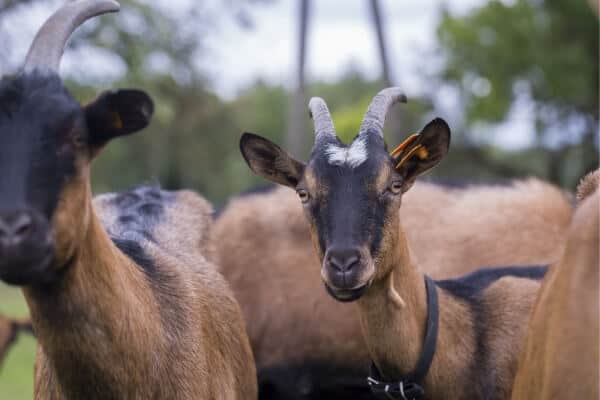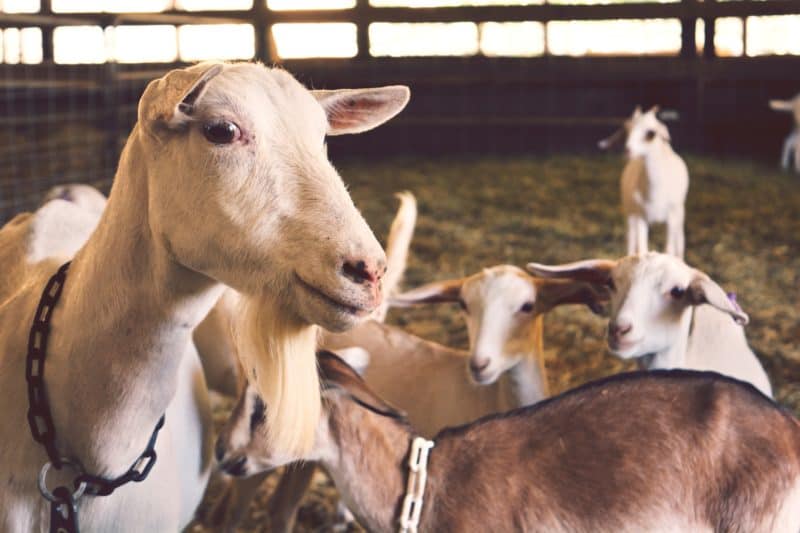There are a lot of different breeds of goat out there and life expectancy varies depending on the breed, although in general, domesticated goats live between 10 and 15 years on average. There are various factors, apart from the breed, which can affect the lifespan of a goat. These are gender, usage and how they are kept (e.g. do they roam more or less wild or do they spend their days on the farm).
This article will go through the main breeds of goats and outline their average lifespan.
Let’s get started!
Contents
Average lifespan of a goat
As with humans, the lifespan of a goat varies depending on its gender, with does tending to live longer than bucks.
Bucks are affected by the stress of the rut, which often causes them to lose interest in food and lose weight. They can also seriously damage one another with their horns during this season.
Although does do usually live longer, they can experience difficult births and this means it is important to wait until your doe is sexually mature before you breed from her.
In general, domesticated goats tend to live between 10 and 15 years, but there are certain breeds which live longer.
There are also some environmental factors which you will need to consider, which can affect a goat’s lifespan.
Breeding
The higher the quality of the parents, the better the quality of their offspring. This means that it is important to know the background of your goat before you buy it. Making sure you buy from a trustworthy source will help ensure you are adding healthy goats to your herd.
Weaker kids, from weak parents are likely to have a lower life expectancy.
Housing and pasture
Your goat will likely live a longer and healthier life if it is provided with well-ventilated housing, which protects him from the worst of the weather.
It is also important to make sure your goat has access to pasture which is not over-grazed, to prevent the spread of disease and worms.
Goats are foragers, so they are best being free to roam around pasture land, at least part of the day.
Diet
Making sure that your goats have clean water, hay, pasture with a variety of vegetation and supplements such as loose minerals will help to keep your animals in tip top condition.
Predators
Good fencing is a must, both to protect your goats and to keep them from escaping! It depends on where you live, of course, but goats can be predated upon by wolves or bobcats. Kids are especially vulnerable and can be preyed upon by foxes and even some of the larger raptors, such as eagles.
Entertainment
Goats are sociable creatures with active minds and bodies, so making sure they are kept stimulated will also help to keep them healthy and happy. Some ideas include: scratching posts, structures to climb e.g. tables, logs, hay bales…, or toys such as balls or toys in which you can hide treats.
Now we’ve had a look at some of the general things which can affect your goat’s lifespan, let’s take a look at some specific breeds.
How long do goats live A – Z
Alpine goats

Alpine goats are an extremely desirable breed for milk production, which originate from France. In general, they have relatively long lifespans for goats, between 15 to 18 years, when given the proper care.
They are a hardy breed and adapt readily to different climates, but like all goats, do require a good, well-ventilated shelter protected from wind and rain.
Anglo Nubian goats

The Anglo Nubian goat is the result of breeding between British and Indian goat breeds. In comparison to other goats, the Anglo-Nubian female produces large quantities of good quality milk. These goats are also used for their meat and skin. As they are quite large animals, they might well need to have their forage
supplemented with grain.
Due to their large ears, they can be susceptible to frostbite in colder climates.
Regular de-worming will also help to keep your Anglo-Nubian goats happy and healthy.
These goats have a lifespan of around 15 to 18 years.
Angora goats

Angora goats are generally raised for their hair, called mohair. They have a relatively short lifespan, in comparison to other breeds – up to around 10 years. Their kids are extremely delicate and must be protected after birth and kept warm and dry. You must make sure that does and bucks are fed well before breeding them, to make sure the kids develop to their full potential.
Angora goats can be sheared several times per year and they must be protected after shearing as they will be more susceptible to the damp and cold. Due to their long coats, it is essential to keep them clean and moisture free. Trimming and bathing them regularly will help to keep them clean and parasite free.
Boer goats
 Boer goats are some of the longest living breed of goat, with bucks living between 8 to 12 years, and the does living up to 20 years. Like their relatives, deer, a goat doe generally tends to live longer than her male counterpart.
Boer goats are some of the longest living breed of goat, with bucks living between 8 to 12 years, and the does living up to 20 years. Like their relatives, deer, a goat doe generally tends to live longer than her male counterpart.
Typically used as meat goats, the Boer is one of the larger goats with an impressive resistance to many diseases. It also is one of the most hardy of the goat breeds, able to cope with a variety of different climates and quite unfussy with what it eats.
These factors contribute to the Boer being a very desirable goat.
Dutch landrace goats
The Dutch landrace is quite a rare breed, which is beginning to grow in popularity and is commonly used to control plant growth. They are more antisocial than many goat breeds and prefer to live apart from humans, in their herd.
Given plenty of room to roam, these goats will live healthily and with little need for human intervention. With the right care, these goats can live up to 15 years.
Nigerian dwarf goats

With their small size and sweet nature, these goats make popular pets. They require less space than larger breeds and are adaptable to most climates. Despite their size, females can produce large quantities of good quality milk. These goats are also great at eating the plants no one else wants, such as poison oak and ivy.
On average, Nigerian Dwarf goats live up to 14 years, given the proper care.
Oberhasli goats

Oberhasli goats are highly regarded for their milk production and are a strong and courageous breed, with a good tolerance for cold climates. They have a lifespan of between 8 to 12 years. Again, this depends on how well they are cared for.
Making sure that your Oberhasli goats have routine health care, such as vaccinations and deworming will help to keep your herd in tip top condition.
Pygmy goats

Pygmy goats are an extremely adaptable breed with the ability to adapt to a range of different climates. They have good disease resistance and does are less susceptible to Mastitis than some other breeds. Although does reach sexual maturity from around 4 to 5 months after birth, it’s better to wait until they’re closer to a year old before breeding from them.
Although pygmy goats are happier with pasture, they can be kept without pasture available. Hay is very important if your goats don’t have access to fresh grass.
In general, pygmy goats can live to around 12 years old, with no differentiation between a buck or doe.
Saanen goats

Saanen goats are generally used for milk production and are rugged goats that are highly adaptable to most climates. They have extremely strong hooves and are resistant to many diseases.
Due to their closely cropped hair and light skin, they need to be protected from sunburn, so always having shade available is extremely important. Their lifespan is from 9 to 15 years.
Like with the other breeds, it is best to wait until the doe is mature before breeding from her – from around 18 months old is best.
Toggenburg goats

The Toggenburg goat is an excellent milk producing goat originating from Switzerland. They prefer cooler climates.
The Toggenburg goats’ life expectancy ranges from 8 to 12 years.
How can I check my goat’s age?
One of the easiest ways to discern your goat’s age, is to check his teeth. Once a goat is born, it will generally grow eight baby teeth in the front lower jaw by the time it is around a month of age. The teeth tend to erupt in pairs, at the rate of around a pair a week, from its birth.
As the goat reaches its first year, the two central baby teeth will be replaced by two adult, permanent teeth.
Remember, goats don’t have incisors in their front upper jaw.
As each year passes, your goat will lose another two baby teeth, which will be replaced by two adult teeth, until they have the full set of eight permanent teeth. This means that a goat with all eight permanent teeth will be at least four years of age.
As they age, the teeth will become increasingly worn so that by the age of ten, there will be clear evidence of having been used frequently! Obviously, this will also depend on the type of feed your goat has had to eat and whether they have had any injuries to their mouth.
In conclusion
So, now we’ve taken a look at how long goats live for and some examples of the typical lifespan of several popular breeds. Whether you choose a small or large breed, your goats will have a greater life expectancy and lead healthier lives if you make sure to feed them well, keep them happy and give them the space they need, as well as keeping their vaccinations up to date, worming them and keeping their hooves well trimmed.
Once you’ve decided on a suitable breed, make sure to do some further research to make sure that you have the right conditions to ensure your goat has a long, comfortable and productive life.



